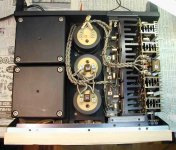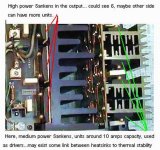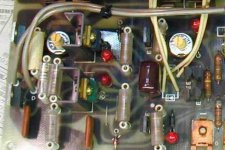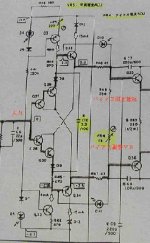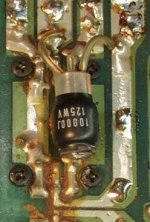It is a Pioneer M-5, I have no specs but only the picture of the insides.
What strikes me as odd is the following:
1) The heatsinks seem small comapred to all other components.
2) The output devices do not add up (assuming complementary) unless you also count the MT-200 devices on the other heatsink.
3) Why is the other heatsink different?
4) 2 Trannies, but 3 Power caps???
What kind of topology has 3 power caps and different kinds of heatsink for output devices (assuming they are output and not some fancy switch mode amp)?
More pictures and clues here (in Japanese): http://amp8.com/tr-amp/pioneer/m5.htm
K-
What strikes me as odd is the following:
1) The heatsinks seem small comapred to all other components.
2) The output devices do not add up (assuming complementary) unless you also count the MT-200 devices on the other heatsink.
3) Why is the other heatsink different?
4) 2 Trannies, but 3 Power caps???
What kind of topology has 3 power caps and different kinds of heatsink for output devices (assuming they are output and not some fancy switch mode amp)?
More pictures and clues here (in Japanese): http://amp8.com/tr-amp/pioneer/m5.htm
K-
Attachments
The devices on the little sinks are the drivers, 4 in parallel.
These run in class A, the ones on the big sink are AB's.
Look at the emitter resistor value of the driver in the schematic.
Pioneer used big Sanken's in parallel on separate heatsinks to handle so much driver dissipation.
Probably the reason the capacitor between the heatsink bursted, i remember how hot the Exclusive series M5 felt.
These run in class A, the ones on the big sink are AB's.
Look at the emitter resistor value of the driver in the schematic.
Pioneer used big Sanken's in parallel on separate heatsinks to handle so much driver dissipation.
Probably the reason the capacitor between the heatsink bursted, i remember how hot the Exclusive series M5 felt.
I took a look at the schematic on the link you posted,Arif:
there are two connections running from Q39 and Q40, these are the connections to the AB output stage.
As only one set is used as drivers, you have a low output class A stage and a high output class AB stage.
Which is not posted, probably because that part was working ok.
(i read the tech article of the Exclusive M5 at the time, also of the M10)
there are two connections running from Q39 and Q40, these are the connections to the AB output stage.
As only one set is used as drivers, you have a low output class A stage and a high output class AB stage.
Which is not posted, probably because that part was working ok.
(i read the tech article of the Exclusive M5 at the time, also of the M10)
Hi K-amps,
I understand how this works since I am working on this kind of output stage. I would love more information on this amplifier and voltage amp stage. Anyone have a manual they can scan?
Depending on the voltage amp stage, this has the promise of sounding really good. The small heatsinks should have the Q27 to Q30 plus Q33 and Q34 on them, It would be nice to have Q35 and Q36 on these also for thermal tracking. The large transistors on the heatsink are indead the outputs. It is a variation of a big diamond setup.
-Chris
I understand how this works since I am working on this kind of output stage. I would love more information on this amplifier and voltage amp stage. Anyone have a manual they can scan?
Depending on the voltage amp stage, this has the promise of sounding really good. The small heatsinks should have the Q27 to Q30 plus Q33 and Q34 on them, It would be nice to have Q35 and Q36 on these also for thermal tracking. The large transistors on the heatsink are indead the outputs. It is a variation of a big diamond setup.
-Chris
The small U-shape sinks on the Toshiba's on the pcb you mean ?
Dont think you'll see many amplifier where you can place the circuit that clear on the pcb.
I love the ML style damping rings on the large resistors on the board, with plastic sleeving to keep their temperature constant.
You want to know their msrp?
Dont think you'll see many amplifier where you can place the circuit that clear on the pcb.
I love the ML style damping rings on the large resistors on the board, with plastic sleeving to keep their temperature constant.
You want to know their msrp?
Guys, I might be off track here but this is the same vintage as the Pioneer Integrated A-80 (150wpc). It also had MT-200's on the main heatsink and some kind of switching OP devices on a smaller heatsink.... The switching OP devices's emitters supplied rail voltage to the main amplifier... actually without the switchers, the main amp ran on +/-45vdc and when triggered, the switchers provided additional juice or +/-20vdc more.
Also no one has theorized on the third large cap... Jacco since you read the original review, perhaps you can dig into those memory banks.. ;-)
Chris, no SM's here, just what I got off that website.
K-
Also no one has theorized on the third large cap... Jacco since you read the original review, perhaps you can dig into those memory banks.. ;-)
Chris, no SM's here, just what I got off that website.
K-
The pcb on the bottom of the amplifier should be the regulated PS's for the front end.
The output of the small heatsink devices go to the outputboard, with +/- 6 volts on 8 MT200 devices the output current should be considerable.
The two big caps with the foil caps in parallel are the PS capacitors for the high power pushpull output stage.
The pcb of the Sanken's on the big heatsink show it's a PP output stage with 3 devices in parallel.
The third big capacitor should be the PS cap for the Vas stage which resides on the big output stage board.
The output of the small heatsink devices go to the outputboard, with +/- 6 volts on 8 MT200 devices the output current should be considerable.
The two big caps with the foil caps in parallel are the PS capacitors for the high power pushpull output stage.
The pcb of the Sanken's on the big heatsink show it's a PP output stage with 3 devices in parallel.
The third big capacitor should be the PS cap for the Vas stage which resides on the big output stage board.
jacco vermeulen said:the PS cap for the Vas stage which resides on the big output stage board.
Oops,
i meant drivers instead of Vas.
The second transformer is not for a powersupply, it's the Vas, like a Mac amplifier.
The class A output on the small heatsinks is there to deliver enough current for the voltage transformer.
Bump ! 
Arif,
did you take a look at the Sansui B2301 too on 8Amps ?
That was a fine power amplifier too, SA/3- P300V range, cost a bundle too, something like 5K$.
There are some strange components on it i've never seen before, any idea what kind of bypass caps the ones on the PS capacitors are ?

Arif,
did you take a look at the Sansui B2301 too on 8Amps ?
That was a fine power amplifier too, SA/3- P300V range, cost a bundle too, something like 5K$.
There are some strange components on it i've never seen before, any idea what kind of bypass caps the ones on the PS capacitors are ?
Jacco,
IN pic 5 (http://amp8.com/sansui/etc/b-2301.htm) the red component on the right is guess what?
IN pic 5 (http://amp8.com/sansui/etc/b-2301.htm) the red component on the right is guess what?
- Status
- This old topic is closed. If you want to reopen this topic, contact a moderator using the "Report Post" button.
- Home
- Amplifiers
- Solid State
- Anyone familiar with this power amp?
